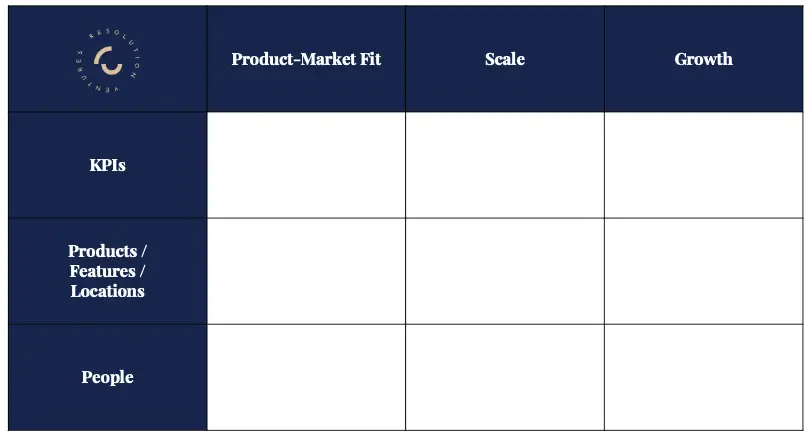Metrics Matrix: Streamlining Early-Stage Due Diligence

Ideally, a seed-stage due diligence process should add value to the companies the VC is engaging with, not just be a waste of time for entrepreneurs. Early in our due diligence process, we engage with entrepreneurs using a simple exercise that we've found beneficial for both parties. It helps entrepreneurs focus on what’s important and crystallize some of their strategic objectives while providing us with better insights into how they think about growing their business. Here’s a breakdown of that exercise.
The Metrics Matrix
When I started angel investing, an experienced angel once asked me, “How do you know the company will reach the right metrics for the next level of funding?” I couldn’t answer that question at the time, so I adapted a simple 3x3 metrics matrix. This framework consolidates information from the current pitch deck, the future pitch deck, and the financial model.
While the metrics matrix is simple, there’s a bit to unpack. It operates across three key phases: Product-Market Fit, Scaling, and Growth.

Product-Market Fit
In the first phase, I look for evidence that the company has found its market and there’s demand for its product. This is akin to building an engine. You might not have a lot of gas in the engine, but you need to demonstrate that it works. If you feed it gas, the moving pieces should start to generate power.
At this stage, KPIs will generally be derivatives of revenue. They might include metrics like the number of contracts in the pipeline or users on the free tier of the product. The product will likely be relatively simple and focused on one market.
Scaling
The second phase represents scalability and corresponds to the next funding round, whether pre-A or Series A. The company has proven demand, and now the focus shifts to scaling the opportunity. Using the car analogy, this is where you drop in the engine, fill the tank with gas, and take it for a test spin. As you press on the gas, you should see a proportional boost in power.
At this stage, KPIs start to focus on cash generation, such as unit economics or recurring gross revenue. I would also start to assess the team since the company will need specialists responsible for refining the product and moving prospects efficiently through the funnel.
Growth
The third phase is growth. By now, the company has proven unit economics but may not yet be profitable because it’s reinvesting in growth. This is where you fine-tune the car, increasing torque and power while expanding its range.
These phases can also be broken down into Team, Product, Repeatable Sale, and Unit Economics, but for simplicity, I prefer the three-phase model.
Using the Metrics Matrix
The first step is determining what you need to raise at each stage to hit milestones that will allow you to raise the next round of funding. Often, founders going through this exercise realize they’re asking for too much in the next round based on what they’re raising now, leading them to adjust their trajectory.
Next, identify the features you need to build at each stage, which may be dictated by customer demand. If the product is customer-facing, it’s generally better to have an internal team building the product to enable faster iterations.
The roadmap should also align with the KPIs. For instance, if customer leads need to increase 5–10x in each funding round, you want to ensure that growth justifies an uplift in valuation. As you move through the lifecycle, KPIs should shift closer to actual cash generation, like revenue or metrics that drive revenue, such as the volume of customer inventory onboarded.
Setting Milestones
Setting milestones helps measure what’s important and provides a reporting framework for investors and stakeholders. It also serves as an early warning system if the growth engine starts to sputter.
By defining milestones early, you can guide investors to the right metrics. Otherwise, investors may ask for unrelated metrics, like LTV/CAC, even if they aren’t relevant.
Summing Up
At each level of funding, check whether you can build the necessary product or service clients at that level. Ensure that the funding is sufficient to hit milestones and maintain momentum. Finally, verify that you’re focusing on the right KPIs—those that the next round of investors will want to see.
While this information might be scattered across financial models, pitch decks, and roadmaps, consolidating it into an easy-to-digest snapshot will help you hit your milestones and convince investors of your plan. Investors won’t spend as much time in the business as the founders, so showing them what to focus on is critical.